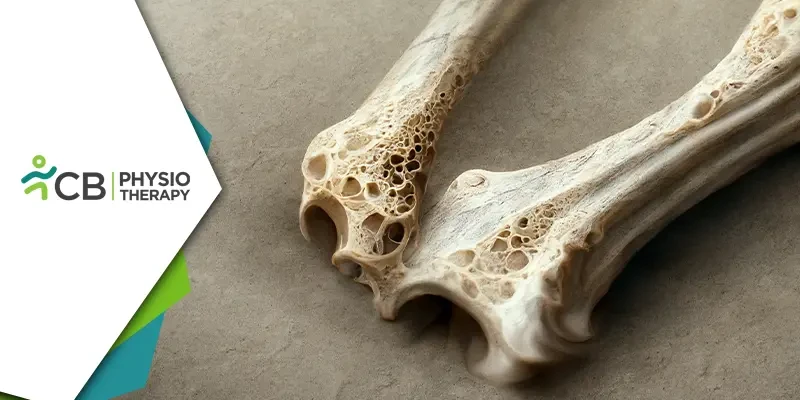Osteoporosis Day on October 20th, 2023, brings with it an opportunity to highlight the importance of bone health and educate individuals about osteoporosis prevention and management. This year's theme, "Build Better Bones," emphasizes the critical role of various approaches in improving bone health. In this blog, we will focus on the crucial role of physiotherapy in combating osteoporosis, managing bone health, and supporting individuals to lead healthier, and more active lives.
Understanding Osteoporosis
Osteoporosis is a bone disease characterized by the weakening of bones, making them fragile and more susceptible to fractures. It is often called a "silent disease" because it typically progresses without any symptoms until a fracture occurs. The gradual loss of bone density and quality is a key feature of osteoporosis.Bone health is of paramount importance throughout our lives. Bones are dynamic structures that constantly undergo a process of remodeling. In this process, old bone tissue is removed (resorption), and new bone tissue is formed (ossification). Osteoporosis occurs when this balance is disrupted, leading to bone loss.
Physiotherapy in Osteoporosis Management
Physiotherapy, a branch of healthcare dedicated to optimizing physical function and movement, plays a vital role in the management and prevention of osteoporosis. Here's how physiotherapy can contribute to building better bones:Assessment and Individualized Exercise Programs: Physiotherapists are trained to conduct thorough assessments of an individual's musculoskeletal system. By evaluating factors such as muscle strength, balance, and posture, they can tailor exercise programs specifically to address the patient's unique needs. These programs may include weight-bearing exercises that help build bone density and improve overall bone health.
1: Fall Prevention: Falls are a significant risk for individuals with osteoporosis, as they can result in fractures. Physiotherapists work on improving balance and coordination, reducing the likelihood of falls. They may also recommend assistive devices, if necessary, to enhance mobility and stability.
2: Pain Management: Osteoporosis can cause chronic pain due to fractures or structural changes in the spine. Physiotherapists employ various techniques, such as TENS, ultrasound, manual therapy, and therapeutic exercises, to alleviate pain and improve mobility.
3: Posture Correction: Poor posture can contribute to spinal deformities in individuals with osteoporosis. Physiotherapists work on correcting posture and preventing the progression of conditions like kyphosis (abnormal curvature of the spine).
4: Core Strengthening: A strong core is essential for maintaining good posture and spinal stability. Physiotherapy programs often include core-strengthening exercises that can enhance overall bone health.
5: Lifestyle Modifications: In addition to exercise, physiotherapists may provide guidance on lifestyle changes, such as nutrition and the prevention of bone-impairing habits, like smoking and excessive alcohol consumption.
Exercises for Osteoporosis
Physiotherapists prescribe a range of exercises to address different aspects of osteoporosis management. Here are a few examples:1: Weight-Bearing Exercises: Activities like walking, jogging, dancing, or stair climbing are excellent for building bone density as they involve weight-bearing on the legs and spine.
2: Resistance Training: Using resistance bands or free weights helps increase muscle strength, which can stabilize the bones and reduce the risk of falls.
3: Balance and Coordination Exercises: Activities like tai chi or yoga improve balance and coordination, which can reduce the risk of falls and fractures.
4: Posture-Correcting Exercises: Exercises that target the muscles supporting the spine can help improve posture and reduce the risk of spinal deformities.
6: Core-Strengthening Exercises: Planks, bridges, and abdominal exercises can help strengthen the core and support the spine.
Community Support and Awareness
Osteoporosis Day provides an opportunity to raise awareness about this condition and the role of physiotherapy in its management. In addition to individualized care, community support, and education are essential:1: Support Groups: Joining osteoporosis support groups can provide individuals with a sense of community and the opportunity to share experiences and coping strategies.
2: Public Awareness Campaigns: Promoting osteoporosis awareness through public campaigns, workshops, and seminars can help dispel myths and encourage early detection and prevention.
3: Collaborative Healthcare: Encouraging a collaborative approach among healthcare professionals, including physiotherapists, doctors, and nutritionists, ensures comprehensive care for those with osteoporosis.
On Osteoporosis Day in 2023, the theme "Build Better Bones" reminds us that osteoporosis is a condition that can be managed and prevented with the right approach. The role of physiotherapy is pivotal in this endeavor, as it not only helps build stronger bones but also improves the overall quality of life for individuals living with osteoporosis. As we raise awareness about this silent disease, let us recognize the vital role of physiotherapy and the potential it holds in supporting individuals to lead healthier, more active lives. Building better bones is not just a theme; it's a call to action, and together, we can make a difference in the fight against osteoporosis.

